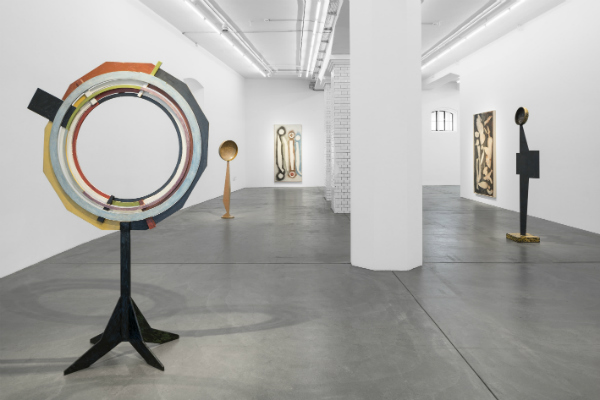
Hauser & Wirth’s debut exhibition of David Smith’s work jumps into the 20th-century American artist’s oeuvre at the deep end. This show of late works finds Smith at his most uncompromising: deeply embedded in areas of artistic inquiry markedly at variance with dominant tendencies of this period.
“David Smith: Form in Color” explores two linked fields: large, brightly colored sculptural works in painted steel, and spray-painted canvases. Smith had a clear affection for industrial materials and processes, but the ends to which he led them were often delicate.
Installation view of David Smith’s “Form in Color” at Hauser & Wirth Zurich. Photo ©The Estate of David Smith, courtesy the Estate and Hauser & Wirth.
In the earliest work exhibited (and perhaps the stand-out canvas of the show), First Ovals (1958), Smith uses an industrially inflected color palette of rust and steely blue-black, sprayed over a dancing arrangement of oval and curved shapes. While only spray enamel is listed as a material, it’s hard to believe that the resulting fleshy tones in the pale, tumbling shapes haven’t also received some brushwork, but however it is achieved, the result is an evocative and mesmerizing arrangement of biomorphic shapes emerging from metallic dusk.
Even in his most decisive steel forms—such as the spare, modernist-homage figures of Ninety Son and Ninety Father—Smith’s use of color is layered and painterly. While from a distance the colored and patterned forms suggest avant la lettre po-mo Memphis-esque razzle, up close they reveal layers of translucent application, with geometrical shapes and tonal planes emerging through the apparently “rough” brushstrokes of the final coat. These are not simply painted sculptures: they are sculptures that carry paintings.
Installation view of David Smith’s “Form in Color” at Hauser & Wirth Zurich. Photo ©The Estate of David Smith, courtesy the Estate and Hauser & Wirth.
Smith’s use of color, in an era that celebrated raw materiality, was troubling. Clement Greenberg, appointed trustee of Smith’s estate when he died in 1965, notoriously had five of the steel sculptures stripped. Revisiting the Smith show after engaging with Hauser & Wirth’s other Zurich exhibition—the excellent and scholarly “Schwitters Miró Arp“—it feels evident that Smith drew inspiration from much further afield than New York.
Circles Intercepted (1961), which is about as delicate a structure you can make out of two meters of welded sheet steel, balances fine flat concentric circles on a base reminiscent of a camera stand. The colors, and refusal to fully inhabit three-dimensions, recall the jutting curves of fragile assemblages and reliefs created by those European artists of the preceding generation—here translated to American heft, proportion, and permanence.
Installation view of David Smith’s “Form in Color” at Hauser & Wirth Zurich. Photo ©The Estate of David Smith, courtesy the Estate and Hauser & Wirth.
Circles Intercepted is elusive—one gazes through it as one would a camera lens, and it is defiantly a two-sided object, with a different coloration on each face. Interestingly, a miniature sibling work Untitled (Chock Full O’Nuts) (1960) explicitly engages with found materials and collage, fusing the metal lids of paint and coffee tins.
The lens-like form of Circles Intercepted gestures towards an unvoiced engagement with photography in Smith’s work. Formed by laying objects onto canvas, his sprays resemble polychrome photograms. As a sculptor, Smith’s awareness of the impact of light, movement, and positioning on a three-dimensional object allowed him to use paint in a way that brought this to the fore.
Installation view of David Smith’s “Form in Color” at Hauser & Wirth Zurich. Photo ©The Estate of David Smith, courtesy the Estate and Hauser & Wirth.
It is only in certain light conditions that Gondola II (1964) reveals itself in three colors rather than two. 7 Hours (1963) seems almost two different works viewed recto and verso. This is sculpture to be experienced and revisited, not glimpsed in the pages of a catalog. Perhaps Smith’s ultimate engagement with photography, then, was to pinpoint its limitations.
“David Smith. Form in Color” is on view at Hauser & Wirth Zurich from June 12-September 18, 2016.